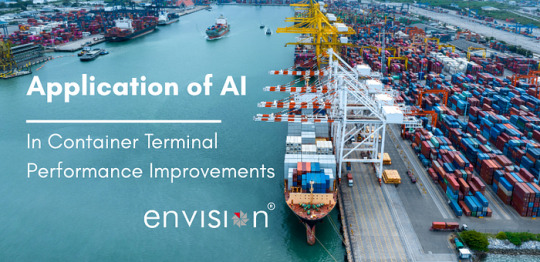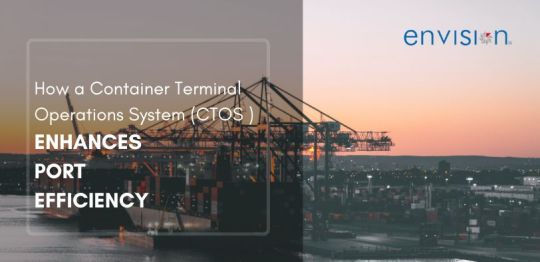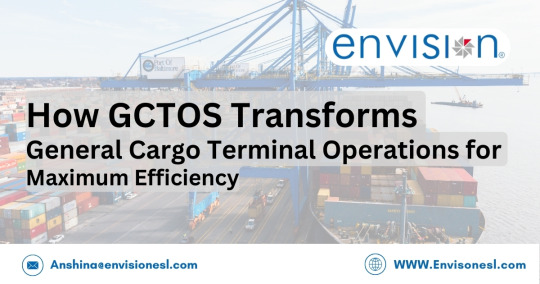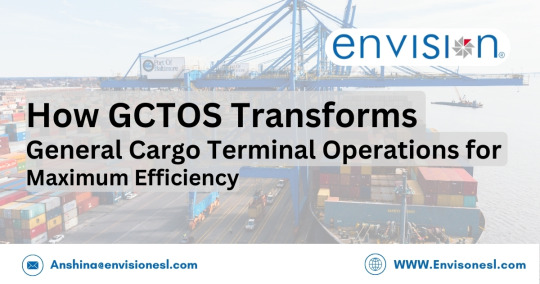#GCTOS
Explore tagged Tumblr posts
Text
Envision's Application of AI in Container Terminal Performance Improvements
Application of AI in Container Terminal Performance Improvements
Introduction
The container terminal sector is poised on the threshold of a technology revolution. With unprecedented pressure from increasing world trade volumes, larger ships, complicated supply chains, and environmental laws, terminals and ports are turning to Artificial Intelligence (AI) to enhance operating performance.

The present article offers in-depth analysis on how AI is being utilized for enhancing container terminal performance, gaining value in areas of operational effectiveness, cost, safety, environment, and customer satisfaction. In addition, we discuss real-life applications, potential future trends, and guidelines on successful AI implementations.
Understanding the Operational Complexities of Container Terminals
Container terminals are the logistics centers where cargo containers are shifted from ships and shore-based transportation like trains and trucks. These terminals are intricate systems consisting of many different activities like:
· Berth allocation and vessel scheduling
· Quay crane operations
· Yard crane and container stack management
· Gate operations for inbound/outbound trucks
· Customs clearance and document processing
· Equipment maintenance and repair
· Container tracking and cargo tracing
Managing these activities efficiently requires precise coordination, real-time data sharing, and the ability to anticipate demand and disruptions — all of which are challenges for legacy terminal operating systems (TOS). This is where AI enters the picture.
Key Applications of AI in Container Terminals
a. AI-Driven Container Yard Optimization
Container yards are the heartbeat of terminal operations. A poorly managed yard leads to container congestion, unnecessary moves, and delays. AI models trained on historical container flows, vessel schedules, and yard layout can:
· Predict future container positions
· Optimize stacking based on expected pickup times
· Reduce unproductive re-handling
· Enhance yard crane scheduling
By dynamically adjusting to demand, AI helps maintain fluidity and maximize throughput — a critical component in achieving container yard optimization.
b. Smart Berth Planning with AI Algorithms
Berth availability is one of the most valuable and limited resources in a container terminal. AI-enhanced berth planning tools analyze multiple variables including:
· Vessel ETA and size
· Quay crane availability
· Weather forecasts
· Tidal data
· Historical berth utilization
They offer real-time re-optimization, allowing for more effective synchronization of vessel arrivals and berth availability. As a consequence, berth utilization rates increase and vessel turnaround times reduce, leading to improved container terminal performance.
c. AI in Empty Container Depot Management
One of the less-stressed but most critical areas of terminal performance is management of empty containers in a depot. Terminals that are handling inland container depots (ICDs) frequently handle substantial quantities of empty containers waiting for repositioning.
AI helps by:
· Predicting container return rates
· Optimizing space allocation
· Coordinating repositioning schedules
· Reducing storage time and costs
Advanced analytics can identify the most cost-effective routes and timings for repositioning, thus improving ICD automation and depot fluidity.
d. Predictive Maintenance for Equipment Reliability
AI-driven predictive maintenance uses machine learning and IoT sensor data to monitor the condition of equipment such as:
· Quay cranes
· Yard gantry cranes
· Reach stackers
· Terminal tractors
AI models detect patterns indicating early signs of wear and failure. Maintenance can then be scheduled before issues escalate, avoiding costly breakdowns and downtime. This approach supports more reliable and safer equipment operations, increasing container terminal performance and asset utilization.
e. Container Freight Station (CFS) Management Optimization
AI is also finding utility in container freight station (CFS) management software, helping improve warehouse management for de-stuffing, stuffing, labeling, and consolidation.
AI systems:
· Predict space and resource needs
· Optimize labor and forklift deployment
· Streamline inventory control
· Automate documentation and customs compliance
CFS operations benefit from increased transparency, faster turnaround, and improved cargo traceability.
3. Enhancing Container Tracking and Tracing with AI
The demand for end-to-end container visibility has never been higher. Delays in container movement can disrupt entire supply chains. AI, combined with IoT and RFID technology, empowers container terminals to:
· Provide real-time tracking of container location and status
· Detect anomalies such as misrouted containers
· Predict estimated time of arrival (ETA) and delays
· Generate alerts for damage, temperature fluctuations, or unauthorized access
By integrating with import/export container logistics platforms, AI ensures that customers and stakeholders are always informed and can act swiftly when disruptions arise.
4. AI for Optimizing Container Drayage Management
Container drayage — short-haul movement of containers between ports and inland terminals — is a significant pain point because of traffic congestion, variable demand, and equipment downtime. AI enhances container drayage management by:
· Optimizing route planning using real-time traffic data
· Predicting truck arrival patterns at terminal gates
· Scheduling pickups and drop-offs with minimal idle time
· Reducing carbon emissions and fuel usage
These enhancements reduce costs of operation and assist in achieving more responsive and sustainable container terminal performance.
5. AI in Gate Operations and Customs Clearance
One of the most time-consuming aspects of terminal operations is gate processing and customs clearance. Long truck queues, document verification, and cargo inspection delays can result in significant inefficiencies.
AI improves gate operations by:
· Automating OCR-based document verification
· Predicting peak gate times for better scheduling
· Integrating customs clearance with AI-powered risk analysis
· Enabling faster green-channel processing for trusted cargo
This significantly reduces truck turnaround time and boosts import/export container logistics efficiency.
6. Integration of AI with IoT and Digital Twins
The strength of AI is amplified when paired with the latest technologies such as IoT and digital twins. Terminal operators are now building virtual copies of their assets — digital twins — that replicate operations in real time.
Key advantages include:
· Visualizing and testing different yard layouts
· Simulating crane deployment strategies
· Monitoring energy consumption and environmental impact
· Running “what-if” scenarios before implementing changes
This proactive approach is essential for future-proofing container depot software and achieving container terminal optimization.
7. Real-World Use Cases and Industry Leaders
a. DP World
DP World’s flagship terminals in Jebel Ali and London Gateway use AI for yard crane automation and predictive analytics to reduce container handling times.
b. Hutchison Ports
Hutchison Ports is integrating AI across its global terminals using intelligent TOS to enable predictive berth planning and real-time monitoring.
c. APM Terminals
APM Terminals deploys AI and sensor data for predictive maintenance. The system forecasts component failures days in advance, preventing costly delays and improving depot management system (DMS) effectiveness.
8. The Broader Impact: Sustainability and Green Ports
AI not only enhances performance but also supports green port initiatives. By:
· Reducing idle time of equipment
· Minimizing rehandling moves
· Optimizing energy usage
· Automating environmental monitoring
AI allows terminals to lower greenhouse gas emissions and meet global environmental standards such as IMO’s carbon reduction goals.
AI-based systems also facilitate ESG (Environmental, Social, and Governance) compliance through monitoring of safety statistics, tracking of waste disposal, and real-time reporting of energy consumption.
9. Preparing for the AI-Driven Future: Strategy and Readiness
AI adoption in container terminals should be viewed as a strategic transformation journey. For successful implementation, terminal operators should:
a. Conduct a Digital Readiness Assessment
Evaluate existing systems, data quality, and infrastructure. Identify areas where AI can bring the quickest and most significant ROI.
b. Choose Scalable and Interoperable Solutions
Select AI platforms that integrate seamlessly with existing TOS, ERP, and logistics platforms to ensure data flow and system compatibility.
c. Build AI Skill Sets Internally
Invest in training operational staff, planners, and maintenance crews in AI literacy. Create cross-functional teams to manage AI projects.
d. Start with Pilot Projects
Begin with small-scale implementations in specific areas (e.g., predictive maintenance, yard planning) to demonstrate impact before scaling up.
e. Partner with Technology Leaders
Collaborate with experienced AI vendors, maritime logistics specialists, and academic institutions to develop customized solutions.
Envision Enterprise Solutions: Empowering the Future of AI-Driven Terminals
Envision Enterprise Solutions is leading the way in AI innovation within the container logistics industry. Through its AI-driven depot management system (DMS) and container depot software integrated together, Envision provides smart solutions that enhance terminal efficiency, reliability, and profitability.
Key offerings include:
· AI-driven container yard optimization tools
· Real-time container tracking and tracing systems
· Smart CFS management software
· Advanced ICD automation modules
· Intelligent container drayage management features
· Predictive analytics for equipment maintenance and workforce scheduling
Envision’s solutions are optimized for large and small terminal operators aiming to digitalize operations, cut costs, and become more competitive within a globalized shipping economy.
With successful roll-outs at top ports and inland terminals, Envision continues to advance the boundaries of AI-powered container terminal performance enhancement.
Why Choose Envision Enterprise Solutions?
Envision Enterprise Solutions stands out as a pioneer in delivering intelligent automation tools tailored for container terminals, ICDs, and depots. Here’s why forward-thinking terminal operators partner with Envision:
a. Domain Expertise
Envision has great industry experience working in maritime logistics, including seaport handling, inland container depots, CFS, and container terminals. This enables them to provide industry-specific solutions rather than generic software applied to ports.
b. End-to-End AI Integration
From yard operations and equipment control to customs clearance and documentation, Envision integrates AI across the entire operational lifecycle — making them a one-stop partner for digital transformation.
c. Proven Track Record
Through effective deployments in a number of countries, Envision’s solutions have continued to enhance terminals’ KPIs such as crane productivity, yard utilization, and turn times.
d. Scalability and Customization
Whether you’re a small regional ICD or a high-volume seaport, Envision’s modular solutions scale to your needs. The software is fully customizable to accommodate local operational nuances.
Envision’s Achievements in Terminal Digitization
Envision has been known for innovation, dependability, and influence in the logistics sector through the years. These include:
Digital Transformation of Asia’s Top Inland Container Depot:
Introduced complete-scale AI-driven automation such as yard planning, drayage scheduling, and real-time tracking. Achieved 35% yard utilization enhancement and 25% dwell time reduction.
Award-Winning CFS Optimization Platform:
Recognized for its intelligent cargo processing and customs documentation module that shortened cargo clearance cycles by up to 40%.
Container Yard Optimization Success in Africa:
Helped a mid-sized terminal reduce unproductive container moves by 30% and increase crane utilization by 20% using AI-based predictive planning.
Global Partner Ecosystem:
Envision has developed strategic alliances with technology vendors, port authorities, and logistics service providers across Asia, Africa, and the Middle East.
Compliance and Sustainability:
Envision’s platforms are compliant with ISO 28000 standards for supply chain security and support carbon tracking for green logistics goals.
Conclusion: AI as the Catalyst for a Smarter Terminal Ecosystem
With supply chains globally growing more complex, container terminals must move from backward-looking, reactive processes to smart, forward-looking environments. It’s not merely a technology improvement to utilize AI in the optimization of container terminal operations — it’s a matter of strategic need.
Whether depot management system (DMS) optimization, automated tracking and tracing of containers, or management of container drayage, AI provides tangible benefits in terms of productivity, safety, customer experience, and sustainability. Terminals that are ready for this change will have a competitive advantage in a growing digital and connected maritime sector.
Container terminals can become tomorrow’s challengers — quicker, brighter, and more environmentally friendly — by unlocking the potential of AI.
Let us show you how AI can elevate your terminal’s performance to the next level.
Contact us today to schedule a personalized demo, explore our success stories, or consult with our maritime logistics experts.
0 notes
Text

Envision (iPortman) CTOS: The Future of Port Management
Envision’s iPortman CTOS is designed to meet today’s operational needs while future-proofing port efficiency.
Key advantages include:
Modular Architecture: Adaptive module-based deployment for scalable container terminal operating system expansion.
Comprehensive Cargo Handling: Supporting imports, exports, and container freight station (CFS) software integration.
All-in-One Port Management: Unifying all operations under a single platform, including vessel planning and optimization.
Mobile App Support: Enhancing real-time data collection and reducing back-office delays.
Customer Portal Integration: Increasing transparency, stakeholder collaboration, and satisfaction.
Advanced Planning & Optimization: Strengthening efficiency in depot management system (DMS) and yard truck management system deployment.
High-Level Reporting Features: Enabling key information about cargo activities, gate transactions, and performance of automated gate systems.
#container terminal operating system#ai powered port management#ports community management#multi cargo terminal operating system#container shipping#container freight station (cfs) software#terminals#envision enterprise solutions#vessel planning and optimization#ctos#Gctos
0 notes
Text
How a Container Terminal Operations System (CTOS) Enhances Port Efficiency
Table of Contents
Introduction
The Evolution of Vessel and Terminal Operations
The Role of a Container Terminal Operating System (CTOS) in Efficiency
Key Factors Influencing Port Efficiency
The Strategic Importance of a CTOS
Envision (iPortman) CTOS: The Future of Port Management
Conclusion
The Evolution of Vessel and Terminal Operations

Hence, it is necessary to invest in new container terminal operating systems (CTOS) and new infrastructure for improved efficiency as well as dock reduction time.
The Role of a Container Terminal Operating System (CTOS) in Efficiency :
With the highly competitive environment, effective terminal operations are essential to retain a competitive advantage. Though capacity expansion of the terminal has been the focus, terminal management software tends to get neglected. A robust container terminal operating system (CTOS) is essential to automate processes and improve service levels.
The primary features of a CTOS are:
Optimized Container Movement Management: Accurate placement of containers within the terminal.
Automated Loading/Unloading Scheduling: Optimizing the utilization of container yard management systems based on real-time shipping data.
Seamless Multi-Modal Integration: Enabling unproblematic road, rail, and sea transportation mode transfers through automated gate system support.
Improved Communication: Providing stakeholders with precise container tracking software updates.
Key Factors Influencing Port Efficiency
Container terminals play a critical role in international logistics by managing cargo handling and intermodal transfers. Several factors impact port efficiency, including:
Yard Size & Layout: Directly influencing storage capacity and movement optimization.
Maritime, Road, and Rail Connectivity: Ensuring efficient cargo transfers between transport networks.
Advanced Machinery: Boosting operational productivity and enhancing automated gate system performance.
Container Terminal Operating System (CTOS): A foundational tool that streamlines operations, from vessel planning and optimization to yard truck management system implementation.
The Strategic Importance of a CTOS
Maximizing efficiency and minimizing costs are key issues for terminal operators. Container terminal operating system (CTOS) simplifies container handling, making cargo flow smooth.
The key benefits of CTOS implementation include:
Reduced Vessel Turnaround Time: Faster cargo handling increases port calls and enhances throughput.
Revenue Optimization: Efficient asset utilization and automated invoice processing improve financial performance.
Lower Operating Costs: Reducing manual operations and leveraging container terminal automation minimizes expenses.
Maximized Resource Utilization: Optimizing asset allocation across yard truck management systems and depot management system (DMS).
Enhanced Transparency & Collaboration: Real-time reporting strengthens stakeholder communication, improving customer satisfaction.
Envision (iPortman) CTOS: The Future of Port Management
Envision’s iPortman CTOS is designed to meet today’s operational needs while future-proofing port efficiency.
Key advantages include:
Modular Architecture: Adaptive module-based deployment for scalable container terminal operating system expansion.
Comprehensive Cargo Handling: Supporting imports, exports, and container freight station (CFS) software integration.
All-in-One Port Management: Unifying all operations under a single platform, including vessel planning and optimization.
Mobile App Support: Enhancing real-time data collection and reducing back-office delays.
Customer Portal Integration: Increasing transparency, stakeholder collaboration, and satisfaction.
Advanced Planning & Optimization: Strengthening efficiency in depot management system (DMS) and yard truck management system deployment.
High-Level Reporting Features: Enabling key information about cargo activities, gate transactions, and performance of automated gate systems.
Conclusion
The use of an advanced container terminal operating system (CTOS) is necessary for maximizing port efficiency, lowering costs, and fueling revenue growth. Envision’s iPortman CTOS presents a comprehensive, future-proof solution that enhances transparency, productivity, and terminal operations.
In today’s competitive global logistics environment, investing in a sophisticated CTOS, along with container yard management system and container freight station (CFS) software, is no longer optional — it’s a necessity.
0 notes
Photo

Fun Friday st Escape Frenzy! #escapefrenzy #weescaped #escaperoom #escapegame #escape #minneapolis (at Escape Frenzy) https://www.instagram.com/p/BvEpNg-gCTo/?utm_source=ig_tumblr_share&igshid=1xe4o6sfpi30a
2 notes
·
View notes
Text
Iran 'Luva de Pedreiro' bate pênalti em São Januário; veja vídeos
Iran ‘Luva de Pedreiro’ bate pênalti em São Januário; veja vídeos
Iran ‘Luva de Pedreiro’ bate pênalti em São Januário; veja vídeos Quarta-feira, 23/03/2022 – 13:37 Força Jovem Vasco @forcajovem70 Simplesmente, po! O @ocaradaluva lançou um “Força Jovem” depois de meter um golaço! Não tem jeito. 💢 Fonte: Twitter GCTO Força Jovem Arena Cruzmaltina @are_cruzmaltina Bate pênalti melhor que o Nenê. RECEBAAAAA! @ocaradaluva Fonte: Twitter Arena Cruzmaltina
View On WordPress
0 notes
Photo

Very Rare. https://www.instagram.com/p/B4tIlE-gCto/?igshid=1pxoqjgzigeny
0 notes
Photo

em Lagoa, Rio de Janeiro https://www.instagram.com/p/B214fh-gCto/?igshid=1fdkzxsnlrn9k
0 notes
Photo

Treino das 13 30 hs concluído. Drills... Gracie Barra Granja Viana do mestre André Sena. Bulldog FF https://www.instagram.com/p/BsbB80-gCtO/?utm_source=ig_tumblr_share&igshid=1b46mbr4alc87
0 notes
Photo

Meister Ambassador Silver Black #BigFace #Ambassador (at Probus NYC)
0 notes
Text
2018 Jobs Vacancy Group Chief Technical Officer (GCTO) Nigeria
2018 Jobs Vacancy Group Chief Technical Officer (GCTO) Nigeria
Career Recruitment – 2018 Jobs Vacancy Group Chief Technical Officer (GCTO) Nigeria Employment Opportunity Nigeria: 2018 Jobs Vacancy Group Chief Technical Officer (GCTO) Nigeria Job Description : Today Work Nigeria
KPMG Professional Services and KPMG Advisory Services are the KPMG member firm in Nigeria. The partners and people have been operating in Nigeria since 1978, providing…
View On WordPress
#current job vacancies in nigeria 2018#current jobs in nigeria 2018#current vacancies in nigeria 2018#employment nigeria 2018#engineering jobs in nigeria 2018#graduate jobs in nigeria 2018#it jobs in nigeria 2018#job recruitment in nigeria 2018#job search in nigeria 2018#job vacancies in abuja 2018#job vacancies in lagos 2018#job vacancies in lagos today 2018#job vacancies in nigeria today 2018#jobs in abuja today 2018#jobs in lagos nigeria 2018#latest job recruitment in nigeria 2018#latest job vacancies in abuja 2018#latest job vacancies in lagos 2018#latest job vacancies in nigeria 2018#latest jobs in abuja 2018#latest jobs in lagos 2018#latest jobs in nigeria today 2018#latest recruitment in nigeria 2018#naija jobs 2018#naijahotjobs 2018#recent job vacancies in nigeria 2018#security jobs in nigeria 2018#teaching jobs in nigeria 2018#vacancies in abuja 2018#vacancy in nigeria 2018
0 notes
Text
0 notes
Text
Response of an ovarian granulosa cell tumor with everolimus and exemestane after initial response to letrozole.
Granulosa cell tumors of the ovaries (GCTO), the most common sex cord tumors of the female genitalia, are characterized by a remarkably favorable prognosis but tend to recur even after several years of follow-up. Standard approach to manage these relapsing tumors is almost inexistent and physicians' choice is most commonly based on his/her personal expertise. Recently, the use of hormone therapy in GCTO has induced prolonged response and survival. In this case report, we report the first successful use of everolimus in the combination of exemestane to reverse the resistance to hormonal therapy with letrozole in a 53-year-old woman with GCTO. Copyright (C) 2017 Wolters Kluwer Health, Inc. All rights reserved. http://ift.tt/2sHWv5n
0 notes
Text
GCTO Força Jovem publica vídeo do trabalho de pintura do muro de sua mega loja; assista
GCTO Força Jovem publica vídeo do trabalho de pintura do muro de sua mega loja; assista
GCTO Força Jovem publica vídeo do trabalho de pintura do muro de sua mega loja; assista Domingo, 27/02/2022 – 08:45 Força Jovem Vasco – FJV @forcajovem70 Parabenizamos Leandro Chokito pelo grande trabalho realizado. Arte indicando o local da nossa Mega Loja, na Rua General Almério de Moura 302, 5º Andar, Vasco da Gama, em frente a Mega Loja do Vasco. Contato do Chokito Grafite: (21)…
View On WordPress
0 notes
Text

How Envision iPortman GCTOS Automates Terminal Operations
New-age marine terminal operators are under pressure to increase efficiency, comply with safety standards, and maximize the use of resources. There has to be a digital-first mentality for monitoring, controlling, and optimizing logistics in real time.
Imagine iPortman is the next-generation multi-cargo terminal operating system that is designed to be an end-to-end solution to inject intelligence into terminal operations, from order to invoice (O2I). It accommodates multi-purpose terminal automation and ensures high-efficiency port operations.
#container freight station (cfs) software#container shipping#container terminal operating system#multi cargo terminal operating system#terminals#ports community management#ai powered port management#smart ports#envision enterprise solutions#iportman
0 notes
Text
How GCTOS Transforms General Cargo Terminal Operations for Maximum Efficiency
The Effects of Trade Expansion on Cargo Terminal Operations
As world trade liberalization and economic growth proceed, the volumes of shipping cargoes have skyrocketed around the globe. There are diverse methods of storage, loading, unloading, and securing for a variety of ships carrying general cargoes. As commodities are demanding more goods, economic development and growth are escalating. In shipping, commodities referred to as general cargo are stored in single compartments. Such types of general cargoes are bulk, break bulk, and liquid bulk.

Key Functions of General Cargo Terminal Operating Systems (GCTOS)
Like a Container Terminal Operating System (CTOS), a General Cargo Terminal Operating System (GCTOS) makes terminal operations smooth through handling:
Efficient Loading and Discharging of cargo
Gate Operations and Truck Management for efficient logistics
Terminal Inventory Management for monitoring cargo movement
Equipment and Gear Productivity to maximize resource use
Yard Utilization to maximize space
A multi-cargo terminal operating system is essential for handling diverse cargo efficiently. The dry bulk TOS and wet bulk TOS optimize cargo movement in bulk segments. Meanwhile, a Ro-Ro TOS is vital for efficient roll-on/roll-off cargo operations. Implementing a universal cargo TOS ensures seamless integration across different cargo types.
Why is General Cargo TOS Important for Contemporary Ports?
Increased global trade and bigger ships make higher-performing terminals with streamlined operations necessary. With increasing competition among ports, terminal operators are now concentrating on improving throughput and operating efficiency.
A General Cargo TOS takes advantage of the latest IT solutions to maximize reliability and balance transaction loads at peak hours. The system is flexible and scalable, minimizing the Total Cost of Ownership (TCO) for terminal operators. In light of the need for efficiency, the proper choice of multi-purpose terminal automation is important to achieve high performance.
Challenges in General Cargo Handling & How GCTOS Solves Them
More than 90% of world cargo by volume and 70% by value are carried on maritime routes. Unlike CTOS, GCTOS has no standardized electronic data interchange system, resulting in complicated cargo manifest handling. Identification of cargo is frequently determined by physical properties such as color and nature, making stevedore operations complicated. Cargo can also require consolidation, repackaging, or sequencing according to FIFO or LIFO principles.
An effective GCTOS simplifies general cargo operations by:
Enhancing bulk cargo handling software for better tracking
Optimizing Equipment Deployment to minimize demurrage charges
Capturing All Billable Activities for accurate invoicing
Maximizing Throughput and Storage to increase efficiency and profitability
Reducing Vessel Turnaround & Dwell Time for seamless operations
Unlike containerized cargo, general cargo has higher exposure to environmental factors, making warehouse management and operational precision critical. Implementing cargo terminal optimization software improves overall operational visibility and efficiency.
How Envision iPortman GCTOS Automates Terminal Operations
New-age marine terminal operators are under pressure to increase efficiency, comply with safety standards, and maximize the use of resources. There has to be a digital-first mentality for monitoring, controlling, and optimizing logistics in real time.
Imagine iPortman is the next-generation multi-cargo terminal operating system that is designed to be an end-to-end solution to inject intelligence into terminal operations, from order to invoice (O2I). It accommodates multi-purpose terminal automation and ensures high-efficiency port operations.
Key Features of iPortman GCTOS
Vessel Management for streamlined docking and unloading
Berth Management for optimizing the utilization of port space
Service Management for enhancing workflow efficiency
Break-bulk cargo management for efficient handling of non-containerized shipments
Cargo Documentation & Operations for import/export monitoring
Yard & Warehouse Operations for organized cargo management
Gate Operations to make entry and exit processes more efficient
Tariff & Invoicing for correct financial management
Seamless Integrations with third-party applications
Reports & Dashboards for data-driven decision-making
Mobility Solutions for real-time monitoring and control on the go
User & System Administration for greater security
A robust car terminal TOS is also incorporated into iPortman GCTOS, ensuring seamless tracking of automotive logistics. Additionally, bulk cargo handling software enhances efficiency in managing loose cargo types.
The Competitive Edge of iPortman GCTOS
iPortman GCTOS provides real-time berth status monitoring, vessel berthing/unberthing recording, and sophisticated cargo delivery processes by rail, road, barge, or conveyor.
A sophisticated tariff module for elastic pricing by transport mode is also available.
Integration Capabilities: Client-configurable positioning detection system with client-specific adaptations.
Security & Mobility: Secure access to encrypted data in both online and offline environments.
User Management: Complete management over audit logs and change logs.
Conclusion
Imagine iPortman GCTOS is made to optimize port efficiency, minimize operating expenses, and enhance cargo handling productivity. With global trade picking up speed, an investment in a sophisticated multi-cargo terminal operating system is no longer a choice but a necessity.
By leveraging cargo terminal optimization software, ports can streamline their operations and achieve higher efficiency. The role of break-bulk cargo management, dry bulk TOS, and wet bulk TOS cannot be understated in modern terminal automation.
To learn more about how iPortman GCTOS can revolutionize your terminal, reach out to Envision now!
#terminals#container freight station (cfs) software#container shipping#logistics#maritime#multi cargo terminal operating system#container terminal operating system#ports community management#ai powered port management#envision enterprise solutions#iportman
0 notes
Text

As world trade liberalization and economic growth proceed, the volumes of shipping cargoes have skyrocketed around the globe. There are diverse methods of storage, loading, unloading, and securing for a variety of ships carrying general cargoes. As commodities are demanding more goods, economic development and growth are escalating. In shipping, commodities referred to as general cargo are stored in single compartments. Such types of general cargoes are bulk, break bulk, and liquid bulk.
Like a Container Terminal Operating System (CTOS), a General Cargo Terminal Operating System (GCTOS) makes terminal operations smooth through handling
#terminals#container terminal operating system#ai powered port management#vessel planning and optimization
0 notes